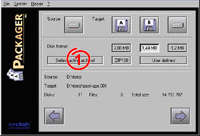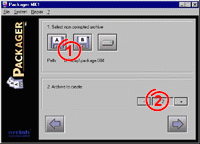 |
The screenshot on the left
shows the start-up screen of Packager
MK1.
For partition of files,
click on button (1).
If you want to restore the
split up files, click at button (2).
|
Choose one of the
following menu items by clicking:
partiton of files
into archives
The
result of splitting up files is to be called
"archive" in the following. The red
numbers inside the screenshots mark the
accompanying explanation.
 |
First,
you have to select the source of the
file(s). By clicking at the
"source"-symbol (1)
you open the
"select-file-dialog", from
which you can choose a file. If you want
to choose more than one file: click at
the first file and press the
"ctrl"-key; you can select
further files by keeping pressed the
"ctrl"-key an click at these
files. |
The
second step is to choose a target drive for the
archives (2). Click either at
the symbol for disk drive A or B! To select
another drive (hard disk etc.), click at the
symbol right beside "disk drive B".
As
archive name you can (but you needn't) keep
"packager.001" for the archive, which
is automatically shown by the
"save-as-dialog".
In
the section "disk format" (3)
you can select the desired archive size by
clicking at these buttons. Standard type is
"1.44 MB" for high-density disks. This
means the archive you create fit in a 1.44MB
disk. You can also select "2.88 MB" an
"1.2 MB" disks or "ZIP100"
for the Iomega ZIP Drive by clicking at these
buttons. If you want to choose a different
archive size, you have to click at the buttons
"user-defined".
The
button "Selfextracting archive" creates
as first archive a self-running .EXE file. To
restore the original source file(s), you won't
need Packager MK1 then! In this case you simply
have to start the first .EXE archive!
If
the error-message "not enough
diskspace" is shown, it means there is still
some data on the disk. To get enought space,
select the item "system", "format
drive" from the menu. Through this menu item
it is also possible to start Windows-Explorer.
The section below (3) shows a
summary of your input. You can now proceed by
clicking button (4).
 |
In the
section (1) a list of
the selected file(s) is shown. Section (2)
shows the progress of the partition.
Below that, you'll see the request to
insert disk 1. If a floppy disk is your
target drive an you haven't yet done so,
insert disk now! If you have chosen a
hard disk as target, this step is
obsolete. |
Now
you can start the partition through a click at
the "GO" button. Insert, if necessary,
one disk after the other when the requests to do
so are shown on the screen. After the partition
is finished a new window appears.
restoring archives
 |
To
restore the original (source) file(s) out
of the created archives you first have to
specify their location. You see in
section (1) three
symbols representing disk A, disk B and
other drives. A click at one of these
symbols opens the
"select-file-dialog" of the
selected drive.. |
This
"select-file-dialog" shows a file,
normally named "packager.001"; it is
the first archive. You have to click at this
archive and then click at the button open.
The
next thing to do is to choose the target
directory for the original (source) file(s) by
clicking at the symbol "target". (2)
In
the section below a summary of your input is
shown. You can now proceed by clicking button (3)
and a new screen appears.
Here
you can see in the upper section a listing of the
included file(s). Below you can see the state of
restoration. If a floppy disk is your source,
insert disk 1 when the request to do so appears
on the screen. In the case you've chosen a hard
disk as source, this step is obsolete. Now you
can start the restoration through a click at the
"GO" button! After the restoration is
finished, a new window appears.
selfextracting
archive
 |
Usually
you need the program Packager MK1 for
restoring files. But if you want to pass
archives to anyone who doesn't have
Packager MK1, it is adviseable to create
selfextracting archives. |
Along
with the partition of the archives you can choose
the option "selfextracting archive"
through a click at the corresponding button (1).
The first archive becomes an autonomous running
program, which is able to restore files without
using Packager MK1.
Instead
of the archive name "package.001" you
will now find a file "package.exe". A
doubleclick at this file starts the restoration.
repair mode for
corrupted archives
 |
It is
possible that one of the disks containing
the archive has an error, for example a
physical fault on a disk. In this case,
Packager MK1 enables you to recreate the
corrupted disk subsequently, so that you
needn't to recreate each disk. |
If
the fault first appears during the restore
process, you can interrupt the restoration,
repair the corrupted disk and proceed with the
restore process ( "Repair/Continue
extraction").
To
start the repair mode, just click at the menu
item "Repair/Create single archive".
In
the now appearing program screen you have to
choose a path via the drive symbols (1)
to a faultless disk that belongs to the set of
disks to which the corrupted disk belongs. Next
you have to give the number of the corrupted
archive, for example "3" for the
corrupted disk "package.003". Then go
to the next program screen. (->)
 |
The next
step is to give the path to the files of
the corrupted disk. You can see the names
of this files in section (3).
After giving the location, go to the next
program screen.(->) |
 |
And now
click at a button to choose the target
drive (for ex. disk A) or a target
directory for the archive you want to
repair. The number behind "#"
recalls the number of the corrupted disk.
Go to the next program screen. |
If
you want to create the archive on a disk, insert
one, when this request appears on the screen! If
you select a hard disk, this step is obsolete and
you can click on the "GO" button
immediatly. This starts the repair mode.
After
you have created a single archive you can
continue to extract the archive by using the menu
item ("Repair/Continue extraction")
Notice:
The repair mode is not available in the shareware
version!
information on the archive
 |
Packager
MK1 gives information on any created
archive, you only have to click on the
menu item ("File/Info"). |
After
selecting the archive by clicking at one of the
drive symbols (1), the program
shows you any information on files, the total
size or the archive and the number of the
selected disk.
unlocking the
shareware version
 |
If you
have registered for the full version of
Packager MK1 (for order
informations click here!), you get your
registration key that unlocks the
program. You can reach the program
screen for unlocking via the menu item
("?/unlock"). After the input
of your personal data and the
registration key, click at the button
"Enter".
|
Now
you've got a full version of Packager MK1!
Thanks
for your order!
|